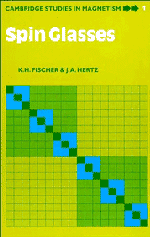Book contents
- Frontmatter
- Contents
- Preface
- 1 Introduction
- 2 Models, order parameters, and systems
- 3 Mean field theory I: Ising model, equilibrium theory
- 4 Introduction to dynamics
- 5 Mean field theory II: Ising dynamics
- 6 Mean field theory III: vector spins
- 7 Short-range interactions: low-temperature properties
- 8 Beyond mean field theory
- 9 Dynamics on many time scales
- 10 Specific heat, sound propagation, and transport properties
- 11 Competition between spin glass and ferromagnetic or antiferromagnetic order
- 12 One-dimensional models
- 13 Random field and random anisotropy
- 14 The physics of complexity
- 15 A short history of spin glasses
- References
- Index
9 - Dynamics on many time scales
Published online by Cambridge University Press: 01 June 2011
- Frontmatter
- Contents
- Preface
- 1 Introduction
- 2 Models, order parameters, and systems
- 3 Mean field theory I: Ising model, equilibrium theory
- 4 Introduction to dynamics
- 5 Mean field theory II: Ising dynamics
- 6 Mean field theory III: vector spins
- 7 Short-range interactions: low-temperature properties
- 8 Beyond mean field theory
- 9 Dynamics on many time scales
- 10 Specific heat, sound propagation, and transport properties
- 11 Competition between spin glass and ferromagnetic or antiferromagnetic order
- 12 One-dimensional models
- 13 Random field and random anisotropy
- 14 The physics of complexity
- 15 A short history of spin glasses
- References
- Index
Summary
Spin glasses differ from most magnetic materials in having dynamics on many timescales. That is, for example, if one measures the susceptibility of a spin glass to fields oscillating with frequencies ω = 1012, 108, 104, 1 and 10−4 sec−1 one may get different results at all the measuring frequencies, indicating that the system has characteristic excitation and relaxation times over (at least) 16 orders of magnitude, ranging from the typical times associated with microscopic spin motions in solids to macroscopic times. For sufficiently low temperatures, this spectrum can extend at the longtime end to geological timescales. (A practical limit is set by the length of time society considers reasonable for a graduate student to complete a Ph.D.) This situation is completely different from that of conventional materials, where for practical purposes measurements at all frequencies less than about 1010 sec−1 would give indistinguishable results.
How are we to understand such properties? In this chapter we review the various kinds of experiments that can be done to probe the dynamical behaviour on timescales ranging from microscopic ones to the longest ones experimenters have the patience to study, and we try to sketch a theoretical picture that enables us to get some insight into what the experimental results mean.
We have actually met this theoretical framework before (often) in the preceding chapters of this book. It is nothing other than our old friend broken ergodicity (introduced in Section 2.4), adapted to the kinds of experimental situations we meet here.
- Type
- Chapter
- Information
- Spin Glasses , pp. 267 - 300Publisher: Cambridge University PressPrint publication year: 1991

